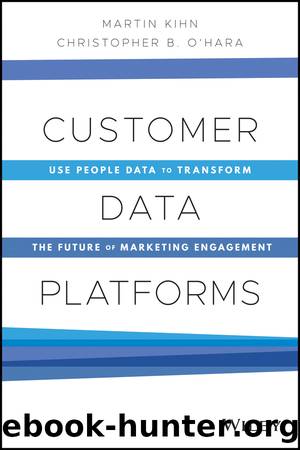Customer Data Platforms: Use People Data to Transform the Future of Marketing Engagement by Martin Kihn & Christopher B. O'Hara

Author:Martin Kihn & Christopher B. O'Hara [Kihn, Martin & Christopher B. O'Hara]
Language: eng
Format: epub
Tags: Business & Economics, Customer Relations, marketing, General, Sales & Selling, Management
ISBN: 9781119790129
Google: 6WsHEAAAQBAJ
Publisher: John Wiley & Sons
Published: 2020-11-05T00:04:03.117522+00:00
Use Cases
This may seem beyond obvious, but data unification for its own sake doesn't produce value. Yes, a âsingle viewâ or âsingle source of truthâ around customer data is highly valuable, but it's akin to writing an encyclopedia that no one has read. Broad and aspirational CDP use cases are needed to start the project (âwe want to transform our entire company around dataâ) but companies need to pay the bills too. What does the marketing department want from data transformation? The analytics team? Defining the initial use cases is crucial to getting the company aligned around creating near-term success, and showing the executive suite that the juice is worth the squeeze. Every use case needs refinement that drives highly specific outcomes.
As an example, if a business goal for the company is âreduce the cost of new customer acquisition,â then that should be aligned to a specific data transformation use case such as ârefine customer segmentation to increase conversion rates on targeted campaigns.â Initial data-driven use cases must have a compelling and measurable outcome. âKnow more about my in-store customerâ is an important, but squishy, goal. âCombine point-of-sale data with digital display campaign data to better understand video media investment in key segments to increase conversion rates by product,â in contrast, is a measurable, achievable goal.
You cannot track the effectiveness of your data transformation without a clear performance framework, and having KPIs to align with is paramount. Many companies start with simple KPIs that show platform adoption. For example, a company with fairly rudimentary segmentation around gender, age, and income might want to add some behavioral characteristics (âsports lovers,â etc.) to start to make creative executions more personal. So the initial goal might be âgo from 20 to 200 segmentsâ but the advanced goal, tied to ROI, might be âuse advanced segmentation to increase conversion rates on online purchase by 5%.â This helps align data and business goals together, such that executive alignment can be achieved more quickly.
Download
This site does not store any files on its server. We only index and link to content provided by other sites. Please contact the content providers to delete copyright contents if any and email us, we'll remove relevant links or contents immediately.
Zero to IPO: Over $1 Trillion of Actionable Advice from the World's Most Successful Entrepreneurs by Frederic Kerrest(4069)
Machine Learning at Scale with H2O by Gregory Keys | David Whiting(3648)
Harry Potter and the Goblet Of Fire by J.K. Rowling(3612)
Never by Ken Follett(3537)
Ogilvy on Advertising by David Ogilvy(3345)
Shadow of Night by Deborah Harkness(3178)
The Man Who Died Twice by Richard Osman(2812)
Book of Life by Deborah Harkness(2723)
My Brilliant Friend by Elena Ferrante(2705)
How Proust Can Change Your Life by Alain De Botton(2617)
0041152001443424520 .pdf by Unknown(2603)
Will by Will Smith(2584)
The Tipping Point by Malcolm Gladwell(2563)
How to Pay Zero Taxes, 2018 by Jeff A. Schnepper(2503)
Purple Hibiscus by Chimamanda Ngozi Adichie(2498)
Hooked: A Dark, Contemporary Romance (Never After Series) by Emily McIntire(2426)
Rationality by Steven Pinker(2153)
Borders by unknow(2119)
Daughter of Smoke and Bone by Laini Taylor(2083)
